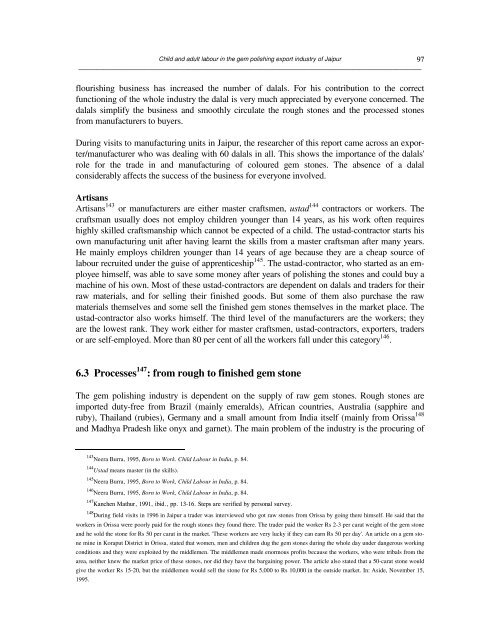Create successful ePaper yourself
Turn your PDF publications into a flip-book with our unique Google optimized e-Paper software.
<strong>Child</strong> <strong>and</strong> <strong>adult</strong> <strong>labour</strong> <strong>in</strong> <strong>the</strong> <strong>gem</strong> polish<strong>in</strong>g <strong>export</strong> <strong>in</strong>dustry <strong>of</strong> Jaipur<br />
──────────────────────────────────────────────────────────────────────────────────────────────<br />
flourish<strong>in</strong>g bus<strong>in</strong>ess has <strong>in</strong>creased <strong>the</strong> number <strong>of</strong> dalals. For his contribution to <strong>the</strong> correct<br />
function<strong>in</strong>g <strong>of</strong> <strong>the</strong> whole <strong>in</strong>dustry <strong>the</strong> dalal is very much appreciated by everyone concerned. The<br />
dalals simplify <strong>the</strong> bus<strong>in</strong>ess <strong>and</strong> smoothly circulate <strong>the</strong> rough stones <strong>and</strong> <strong>the</strong> processed stones<br />
from manufacturers to buyers.<br />
Dur<strong>in</strong>g visits to manufactur<strong>in</strong>g units <strong>in</strong> Jaipur, <strong>the</strong> researcher <strong>of</strong> this report came across an <strong>export</strong>er/manufacturer<br />
who was deal<strong>in</strong>g with 60 dalals <strong>in</strong> all. This shows <strong>the</strong> importance <strong>of</strong> <strong>the</strong> dalals'<br />
role for <strong>the</strong> trade <strong>in</strong> <strong>and</strong> manufactur<strong>in</strong>g <strong>of</strong> coloured <strong>gem</strong> stones. The absence <strong>of</strong> a dalal<br />
considerably affects <strong>the</strong> success <strong>of</strong> <strong>the</strong> bus<strong>in</strong>ess for everyone <strong>in</strong>volved.<br />
Artisans<br />
Artisans 143 or manufacturers are ei<strong>the</strong>r master craftsmen, ustad 144 contractors or workers. The<br />
craftsman usually does not employ children younger than 14 years, as his work <strong>of</strong>ten requires<br />
highly skilled craftsmanship which cannot be expected <strong>of</strong> a child. The ustad-contractor starts his<br />
own manufactur<strong>in</strong>g unit after hav<strong>in</strong>g learnt <strong>the</strong> skills from a master craftsman after many years.<br />
He ma<strong>in</strong>ly employs children younger than 14 years <strong>of</strong> age because <strong>the</strong>y are a cheap source <strong>of</strong><br />
<strong>labour</strong> recruited under <strong>the</strong> guise <strong>of</strong> apprenticeship 145 . The ustad-contractor, who started as an employee<br />
himself, was able to save some money after years <strong>of</strong> polish<strong>in</strong>g <strong>the</strong> stones <strong>and</strong> could buy a<br />
mach<strong>in</strong>e <strong>of</strong> his own. Most <strong>of</strong> <strong>the</strong>se ustad-contractors are dependent on dalals <strong>and</strong> traders for <strong>the</strong>ir<br />
raw materials, <strong>and</strong> for sell<strong>in</strong>g <strong>the</strong>ir f<strong>in</strong>ished goods. But some <strong>of</strong> <strong>the</strong>m also purchase <strong>the</strong> raw<br />
materials <strong>the</strong>mselves <strong>and</strong> some sell <strong>the</strong> f<strong>in</strong>ished <strong>gem</strong> stones <strong>the</strong>mselves <strong>in</strong> <strong>the</strong> market place. The<br />
ustad-contractor also works himself. The third level <strong>of</strong> <strong>the</strong> manufacturers are <strong>the</strong> workers; <strong>the</strong>y<br />
are <strong>the</strong> lowest rank. They work ei<strong>the</strong>r for master craftsmen, ustad-contractors, <strong>export</strong>ers, traders<br />
or are self-employed. More than 80 per cent <strong>of</strong> all <strong>the</strong> workers fall under this category 146 .<br />
97<br />
6.3 Processes 147 : from rough to f<strong>in</strong>ished <strong>gem</strong> stone<br />
The <strong>gem</strong> polish<strong>in</strong>g <strong>in</strong>dustry is dependent on <strong>the</strong> supply <strong>of</strong> raw <strong>gem</strong> stones. Rough stones are<br />
imported duty-free from Brazil (ma<strong>in</strong>ly emeralds), African countries, Australia (sapphire <strong>and</strong><br />
ruby), Thail<strong>and</strong> (rubies), Germany <strong>and</strong> a small amount from <strong>India</strong> itself (ma<strong>in</strong>ly from Orissa 148<br />
<strong>and</strong> Madhya Pradesh like onyx <strong>and</strong> garnet). The ma<strong>in</strong> problem <strong>of</strong> <strong>the</strong> <strong>in</strong>dustry is <strong>the</strong> procur<strong>in</strong>g <strong>of</strong><br />
143 Neera Burra, 1995, Born to Work. <strong>Child</strong> Labour <strong>in</strong> <strong>India</strong>, p. 84.<br />
144 Ustad means master (<strong>in</strong> <strong>the</strong> skills).<br />
145 Neera Burra, 1995, Born to Work, <strong>Child</strong> Labour <strong>in</strong> <strong>India</strong>, p. 84.<br />
146 Neera Burra, 1995, Born to Work, <strong>Child</strong> Labour <strong>in</strong> <strong>India</strong>, p. 84.<br />
147 Kanchen Mathur, 1991, ibid., pp. 13-16. Steps are verified by personal survey.<br />
148 Dur<strong>in</strong>g field visits <strong>in</strong> 1996 <strong>in</strong> Jaipur a trader was <strong>in</strong>terviewed who got raw stones from Orissa by go<strong>in</strong>g <strong>the</strong>re himself. He said that <strong>the</strong><br />
workers <strong>in</strong> Orissa were poorly paid for <strong>the</strong> rough stones <strong>the</strong>y found <strong>the</strong>re. The trader paid <strong>the</strong> worker Rs 2-3 per carat weight <strong>of</strong> <strong>the</strong> <strong>gem</strong> stone<br />
<strong>and</strong> he sold <strong>the</strong> stone for Rs 50 per carat <strong>in</strong> <strong>the</strong> market. 'These workers are very lucky if <strong>the</strong>y can earn Rs 50 per day'. An article on a <strong>gem</strong> stone<br />
m<strong>in</strong>e <strong>in</strong> Koraput District <strong>in</strong> Orissa, stated that women, men <strong>and</strong> children dug <strong>the</strong> <strong>gem</strong> stones dur<strong>in</strong>g <strong>the</strong> whole day under dangerous work<strong>in</strong>g<br />
conditions <strong>and</strong> <strong>the</strong>y were exploited by <strong>the</strong> middlemen. The middlemen made enormous pr<strong>of</strong>its because <strong>the</strong> workers, who were tribals from <strong>the</strong><br />
area, nei<strong>the</strong>r knew <strong>the</strong> market price <strong>of</strong> <strong>the</strong>se stones, nor did <strong>the</strong>y have <strong>the</strong> barga<strong>in</strong><strong>in</strong>g power. The article also stated that a 50-carat stone would<br />
give <strong>the</strong> worker Rs 15-20, but <strong>the</strong> middlemen would sell <strong>the</strong> stone for Rs 5,000 to Rs 10,000 <strong>in</strong> <strong>the</strong> outside market. In: Aside, November 15,<br />
1995.


















